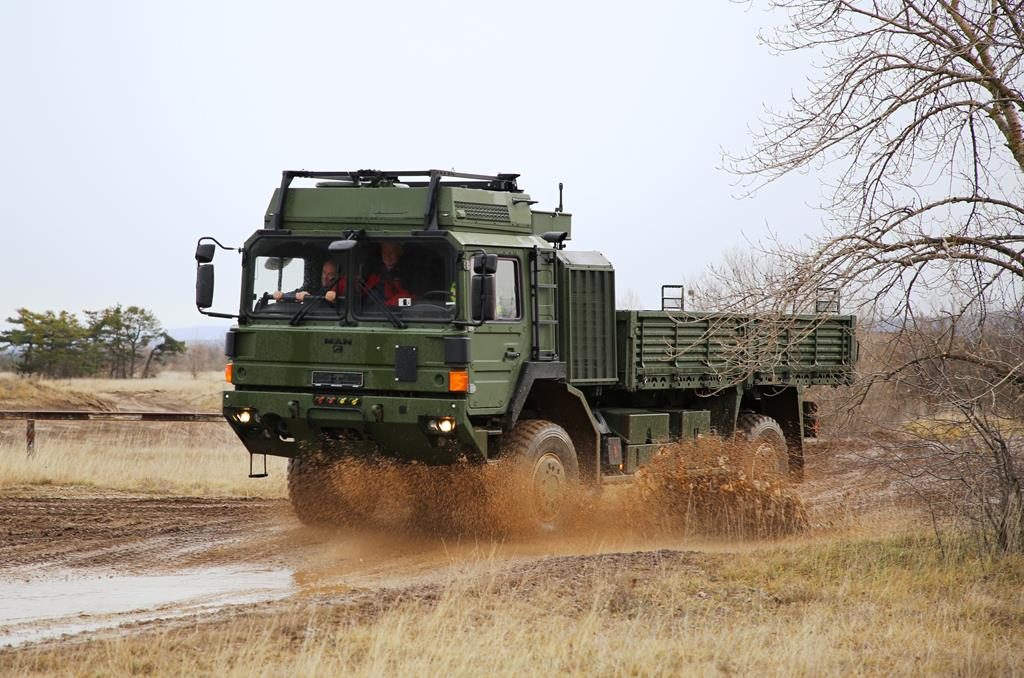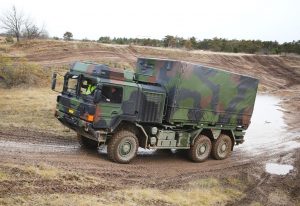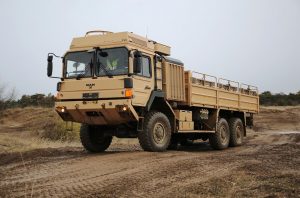
RMMV Vienna: trucks production on the rise
The facility in Vienna where RMMV trucks are built has been delivering busses since 1922, when Perl Busses was created. In 2007 the first military trucks were built there, those that are now serving with the United Kingdom armed forces as part of the UK Vehicle Support Fleet contract, which included 7,500 vehicles. As that contract was coming to an end, crisis was looming over the company located in Brunner strasse, in the Liesing district, south-west of Vienna. However the Phase 3B of the Australian Land 121 programme was won, the delivery of 2,540 vehicles being scheduled between 2016 and 2020. Since then, RMMV won other contracts, which allow to ensure a steady flow of work for the coming years.

The Business Unit Logistic Vehicles is part of the wider Rheinmetall Vehicle Systems Division, which also includes the Business Unit Tactical Vehicles, producing both tracked and wheeled vehicles. The Business Unit is busy in delivering white fleet vehicles, that is commercial trucks in use with the Armed Forces, and not only, Militarised Trucks, and Military Trucks. Commercial trucks are the simplest to deliver, as they do not need any specific customisation, militarised trucks requiring quite some work, as it is not just a matter of mounting sand tires; a centralised tire inflation system (CTIS) is usually installed, the integration of a C4I suite requiring a lower EMC signature being also part of the work. Moreover many customers, Sweden among others, are now asking for a reinforced roof, which would allow installing a ring-mounted machine gun or even a light remotely controlled weapon station.

However the true raison d’être of this plant is the production of military trucks, that is the HX family, currently produced at the HX2 standard. These are developed and designed in Vienna, RMMV being the design authority, the company having over 160 engineers in its R&D department. All HX trucks, from 4×4 to 8×8, are fitted with MAN axles, the front one being an 11 tons drive/steer axle. Engines, also provided by MAN, can be chosen with an output of 340 hp, 440 hp, 540 hp and 680 hp, depending on the vehicle and of the use. Normally the unprotected and the protected versions of a truck feature the same engine, extra power being sufficient to ensure maximum mobility even to the heavier protected version, only acceleration being slightly affected. Designed for heavy off-road use, HX trucks maintains numerous similarities among them, the family effect easing training and maintenance duties. As for their toughness, this has been demonstrated in a test at Wehrtechnische Dienststelle 41 (WTD 41) in Trier, the test centre for military vehicles belonging to the Bundesamtes für Ausrüstung, Informationstechnik und Nutzung der Bundeswehr (BAAINBw), the Federal Office of Bundeswehr Equipment, Information Technology and In-Service Support: an HX2 8×8 was tested eight times in a row on a tank test track, on which a wheeled vehicle is not meant to perform, surviving more than well that torture test.

The Rheinmetall facility in Vienna goes beyond a simple truck OEM, its R&D department being constantly looking for new technical solutions. One of these is the adoption of a torsion-free subframe dedicated to HX trucks, allowing decoupling the payload from the vehicle in terms of torsion; compared to standard solutions in use, this allows cutting weight by about 400 kg, which are immediately transformed into payload, and to reduce the overall height, with beneficial effects on stability. These new frames are also assembled on the production line in Vienna. A typical R&D work is C4I integration into the cabin; currently the most advanced C4I architecture which is being integrated into HX trucks is the one required by the Bundeswehr into the vehicles part of the Ungeschützte Transportfahrzeuge (UTF) contract, their cabin being the one requiring the longest assembly time. Its roof, strengthened to accept a light weapon station, is fitted with air conditioning, as well as NBC filtration system for protected cabs, a box for the machine gun spare barrel, and a GPS antenna; armoured cabins are produced at Rheinmetall’s plant in Unterlüß, northern Germany. The company also started designing and producing its own subsystems, such as the Automated Loading Handling System, unveiled at Eurosatory 2018, allowing automated loading and unloading of containers, modules and flat racks onto military trucks, the crew operating inside the protected truck cabin. Developed by Supashock, an Australian company of which Rheinmetall acquired 49% of the shares in July 2017, it is known as ALHS17, the number indicating the maximum weight of 17 tons. The system allows dealing with misalignment between the vehicle and the load, as well as situations such as mud and sand, where no access to the bottom corner fittings may be possible; it exploits the two top corners top of the load, and is compatible with all ISO containers/modules and STANAG-compliant flat racks. The system was seen on the production line installed on one of the trucks ready to be delivered to Australia.
Production
With the production of Land 121 Phase 3 B for Australia running until 2020, the framework contract for Norway and Sweden that has a potential up to 2,000 trucks running until 2026, that of the UTF German contract concerning potentially 2,271 trucks planned until 2023 (105 of the 110 planned for the current year have already been delivered, the remaining being currently under delivery, 558 having been ordered with the first contract), the new Land 121 Phase 5B contract for further 1,044 trucks planned from 2020 to 2024, the production line in Vienna will be quite busy in the next years. Other contracts are also running for customers that ordered smaller quantities, usually between 50 and 200 trucks. Currently the plant is delivering 11 trucks per day in one working shift, usually 10 standard trucks per day and one specific truck, such as i.e. a 10×10. It is to note that the latter is the only one that does not use an all-MAN axels solution; while it keeps the front 11 tons drive/steer axel, rear axles are provided by Sisu and feature hydropneumatic suspensions instead of the usual leaf springs. The average amount of work required is around 300 hours per truck, although some specific vehicles can require more than the double, Australian 10×10 reaching 800 hours. The aim of Rheinmetall is to increase the production up to 14 trucks per day; this will be done improving the layout of the production line and increasing the workforce, the aim being to reach 12 trucks per day in mid-2019, 13 in late 2019 and finally 14 in mid-2020. The blue collar workforce in Vienna is around 500 people, the assembly line working as said on one shift while the painting and parts manufacturing, the company produces internally all hydraulics piping, work on 2.5 shifts.

On Line 1, the one dedicated to standard HX trucks production, work is organised on 31 Takt positions, each served by 6-8 workers, Takt time[1] being of 45 minutes. A U-shaped line, the first part is dedicated to chassis assembly, and brings up to the painting area; as this process cannot match the Takt time, a buffer zone has been created. The company is equipped with laser cutting machinery, bending and welding systems, which account for 20% of the production, usually small series or prototypes, while 80% of this work is subcontracted, chassis elements being thus delivered to the Brunner strasse facility ready for assembly. Chassis painting is not required for commercial trucks, however to cope with the strict military standards this remains a must for the HX line. Following the treatment with solvent-based paint, the assembly continues, with the integration of superstructures; the need to have a 1.5 meters fording depth capability led to the design of an integrated cooling unit which is mounted at the rear of the cabin, another unique feature of RMMV trucks. Currently 6 cabins for military models are produced per day in Vienna, integration of C4I and other elements being the key issue; as the percent of HX trucks versus militarised and commercial trucks is increasing, the company is looking at thrusting the cabin production up to 10 per day. RMMV Vienna will take profit of the incoming Christmas break to modify the cabin assembly area layout, and aims achieving the new production ratio in early 2019. Once the truck is assembled, it enters the test cabin, where each vehicle is submitted to a 45 minutes test in different load conditions; this is followed by the final tuning, after which it is declared ready for delivery.
Looking forward
In order to cope with strict anti-pollution regulations, RMMV is working together with MAN on a new Euro 6 engine and exhaust washing system that will allow military trucks to use NATO standard quality fuel. Difficulties stem mostly from the vibrations to which a military truck is submitted, which considerably affect the highly complex system. Not yet available, when this will be installed it will allow trucks to deploy downrange using without problems both standards as well as jet fuel. RMMW and MAN aim at qualifying the new propulsion system by late 2019, when it will become the first military powerpack at Euro 6D standard available on the market.
However this is far from being the only innovative element to which RMMW is looking with interest. The acquisition of Supashock shares was not aimed simply at the ALHS17, the main interest being the company know-how in the suspension field, active and passive reactive suspensions being part of the Australian company portfolio. An 8×8 chassis should soon be equipped with active suspensions for trials, while other innovations are being considered, i.e. in the cabins and in the vetronics areas. The company is also thinking to what the future trucks driveline might look; while all electric will probably never be a solution in the military field, hybrid solutions might well become viable. What seems clear is that at Eurosatory 2020 RMMV will show its concept for a next generation truck.
[1] Takt time is the average time between the start of production of one unit and the start of production of the next unit.
If you want to visit the GALLERY, please click HERE
